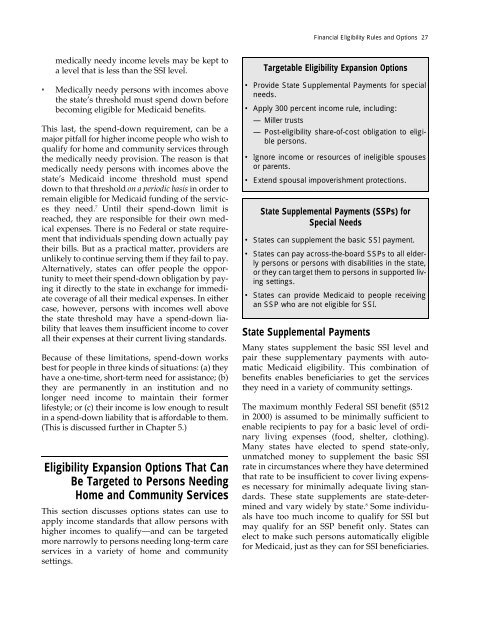Full PDF Version - ASPE - U.S. Department of Health and Human ...
Full PDF Version - ASPE - U.S. Department of Health and Human ...
Full PDF Version - ASPE - U.S. Department of Health and Human ...
- No tags were found...
You also want an ePaper? Increase the reach of your titles
YUMPU automatically turns print PDFs into web optimized ePapers that Google loves.
Financial Eligibility Rules <strong>and</strong> Options 27medically needy income levels may be kept toa level that is less than the SSI level.• Medically needy persons with incomes abovethe state’s threshold must spend down beforebecoming eligible for Medicaid benefits.This last, the spend-down requirement, can be amajor pitfall for higher income people who wish toqualify for home <strong>and</strong> community services throughthe medically needy provision. The reason is thatmedically needy persons with incomes above thestate’s Medicaid income threshold must spenddown to that threshold on a periodic basis in order toremain eligible for Medicaid funding <strong>of</strong> the servicesthey need. 7 Until their spend-down limit isreached, they are responsible for their own medicalexpenses. There is no Federal or state requirementthat individuals spending down actually paytheir bills. But as a practical matter, providers areunlikely to continue serving them if they fail to pay.Alternatively, states can <strong>of</strong>fer people the opportunityto meet their spend-down obligation by payingit directly to the state in exchange for immediatecoverage <strong>of</strong> all their medical expenses. In eithercase, however, persons with incomes well abovethe state threshold may have a spend-down liabilitythat leaves them insufficient income to coverall their expenses at their current living st<strong>and</strong>ards.Because <strong>of</strong> these limitations, spend-down worksbest for people in three kinds <strong>of</strong> situations: (a) theyhave a one-time, short-term need for assistance; (b)they are permanently in an institution <strong>and</strong> nolonger need income to maintain their formerlifestyle; or (c) their income is low enough to resultin a spend-down liability that is affordable to them.(This is discussed further in Chapter 5.)Eligibility Expansion Options That CanBe Targeted to Persons NeedingHome <strong>and</strong> Community ServicesThis section discusses options states can use toapply income st<strong>and</strong>ards that allow persons withhigher incomes to qualify—<strong>and</strong> can be targetedmore narrowly to persons needing long-term careservices in a variety <strong>of</strong> home <strong>and</strong> communitysettings.Targetable Eligibility Expansion Options• Provide State Supplemental Payments for specialneeds.• Apply 300 percent income rule, including:— Miller trusts— Post-eligibility share-<strong>of</strong>-cost obligation to eligiblepersons.• Ignore income or resources <strong>of</strong> ineligible spousesor parents.• Extend spousal impoverishment protections.State Supplemental Payments (SSPs) forSpecial Needs• States can supplement the basic SSI payment.• States can pay across-the-board SSPs to all elderlypersons or persons with disabilities in the state,or they can target them to persons in supported livingsettings.• States can provide Medicaid to people receivingan SSP who are not eligible for SSI.State Supplemental PaymentsMany states supplement the basic SSI level <strong>and</strong>pair these supplementary payments with automaticMedicaid eligibility. This combination <strong>of</strong>benefits enables beneficiaries to get the servicesthey need in a variety <strong>of</strong> community settings.The maximum monthly Federal SSI benefit ($512in 2000) is assumed to be minimally sufficient toenable recipients to pay for a basic level <strong>of</strong> ordinaryliving expenses (food, shelter, clothing).Many states have elected to spend state-only,unmatched money to supplement the basic SSIrate in circumstances where they have determinedthat rate to be insufficient to cover living expensesnecessary for minimally adequate living st<strong>and</strong>ards.These state supplements are state-determined<strong>and</strong> vary widely by state. 8 Some individualshave too much income to qualify for SSI butmay qualify for an SSP benefit only. States canelect to make such persons automatically eligiblefor Medicaid, just as they can for SSI beneficiaries.
















